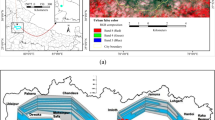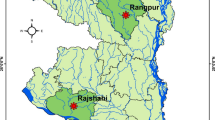Abstract
The groundwater consumption for agriculture has increased since the green revolution, and its depletion severely threatens food security, especially in major rice-growing areas of Southeast Asia. This research investigated the spatiotemporal distribution of land use land cover (LULC) from 2000 to 2018 in a rice-dominated canal command area. The study compared the classification performance of two machine learning algorithms, i.e., Support Vector Machines (SVM) and Random Forest (RF). The time-varying response of LULC transition on groundwater dynamics was investigated using a 3-D numerical groundwater flow model (MODFLOW-NWT). The MODFLOW-NWT model was calibrated and validated with the observed hydraulic heads. The results indicated that RF outperformed SVM in overall classification during the testing period. The LULC of the command area revealed a seven-fold increase in built-up area from 19.12 km2 in 2000 to 133.72 km2 in 2018. Further, the Boro rice cultivated area has increased from 39.2% to 56.4% of the command area during the study period. The results of transient state calibration (R2 = 0.987, NSE = 0.987) and validation (R2 = 0.978, NSE = 0.974) of MODFLOW-NWT indicated satisfactory match between simulated hydraulic heads and observed hydraulic heads. The area under the hydraulic head of -32 m to -5 m was consistently increasing, which requires contemplation on the future sustainability of groundwater. The methodology and results of this study can be used for LULC classification in a heterogeneous landscape and accurate groundwater flow simulation in data inadequacy scenarios in major rice-growing areas of Southeast Asia.





Similar content being viewed by others
Availability of Data and Materials
The data used in this study were acquired from different secondary sources. Some of the data are publicly available and their references are provided in the manuscript. Other restricted data are available from the corresponding author upon reasonable request and with permission of the source department.
References
Abdi AM (2020) Land cover and land use classification performance of machine learning algorithms in a boreal landscape using Sentinel-2 data. Gisci Remote Sens 57(1):1–20
Acharjee TK, Ludwig F, van Halsema G, Hellegers P, Supit I (2017) Future changes in water requirements of Boro rice in the face of climate change in North-West Bangladesh. Agric Water Manag 194:172–183
Albhaisi M, Brendonck L, Batelaan O (2013) Predicted impacts of land use change on groundwater recharge of the upper Berg catchment, South Africa. Water SA 39(2):211–220
Amanambu AC, Obarein OA, Mossa J, Li L, Ayeni SS, Balogun O, Ochege FU (2020) Groundwater system and climate change: Present status and future considerations. J Hydrol 589:125163
Beyer F, Jurasinski G, Couwenberg J, Grenzdörffer G (2019) Multisensor data to derive peatland vegetation communities using a fixed-wing unmanned aerial vehicle. Int J Remote Sens 40(24):9103–9125
Breiman L (2001) Random Forests. Mach Learn 45(1):5–32
Central Ground Water Board (CGWB) (2017) National compilation on dynamic ground water resources of India. Ministry of Water Resources, River Development and Ganga Rejuvenation, Government of India. http://cgwb.gov.in/GW-Assessment/GWRA-2017-National-Compilation.pdf
Cortes C, Vapnik V (1995) Support-vector networks. Mach Learn 20(3):273–297. https://doi.org/10.1007/bf00994018
Dams J, Dujardin J, Reggers R et al (2013) Mapping impervious surface change from remote sensing for hydrological modeling. J Hydrol 485:84–95
Foody GM, Mathur A (2004) Toward intelligent training of supervised image classifications: directing training data acquisition for SVM classification. Remote Sens Environ 93(1–2):107–117
Freeze RA, Cherry JA (1979) Groundwater. Prentice-Hall, Englewood Cliffs, New Jersey, p 604
Gibbs HK, Ruesch AS, Achard F, Clayton MK, Holmgren P, Ramankutty N, Foley JA (2010) Tropical forests were the primary sources of new agricultural land in the 1980s and 1990s. Proc Natl Acad Sci 107(38):16732–16737
Ground Water Estimation Committee (GEC) (1997) Ground Water Estimation Methodology – 1997. Ministry of Water Resources, River Development and Ganga Rejuvenation, Government of India
Harbaugh AW (2005) MODFLOW-2005, the US Geological Survey modular ground-water model: the ground-water flow process (pp. 6-A16). Reston, VA, USA: US Department of the Interior. US Geol Surv
Khadim FK, Dokou Z, Lazin R, Moges S, Bagtzoglou AC, Anagnostou E (2020) Groundwater modeling in data scarce aquifers: the case of Gilgel-Abay, Upper Blue Nile, Ethiopia. J Hydrol 590:125214
Mainuddin M, Maniruzzaman MD, Alam MM, Mojid MA, Schmidt EJ, Islam MT, Scobie M (2020) Water usage and productivity of Boro rice at the field level and their impacts on the sustainable groundwater irrigation in the North-West Bangladesh. Agric Water Manag 240:106294
Mansaray LR, Wang F, Huang J, Yang L, Kanu AS (2020) Accuracies of support vector machine and random forest in rice mapping with Sentinel-1A, Landsat-8 and Sentinel-2A datasets. Geocarto Int 35(10):1088–1108
Maxwell AE, Warner TA, Fang F (2018) Implementation of machine-learning classification in remote sensing: An applied review. Int J Remote Sens 39(9):2784–2817
McDonald MG, Harbaugh AW (1988) A modular three-dimensional finite-difference ground-water flow model. US Geolog Surv
Narany TS, Aris AZ, Sefie A, Keesstra S (2017) Detecting and predicting the impact of land use changes on groundwater quality, a case study in Northern Kelantan, Malaysia. Sci Total Environ 599:844–853
Niswonger RG, Panday S, Ibaraki M (2011) MODFLOW-NWT, a Newton formulation for MODFLOW-2005. US Geol Surv Tech Methods 6(A37):44
Omar PJ, Gaur S, Dwivedi SB, Dikshit PKS (2020) A modular three-dimensional scenario-based numerical modelling of groundwater flow. Water Resour Manag 34(6):1913–1932
Onojeghuo AO, Blackburn GA, Wang Q, Atkinson PM, Kindred D, Miao Y (2018) Mapping paddy rice fields by applying machine learning algorithms to multi-temporal Sentinel-1A and Landsat data. Int J Remote Sens 39(4):1042–1067
Patra S, Sahoo S, Mishra P, Mahapatra SC (2018) Impacts of urbanization on land use/cover changes and its probable implications on local climate and groundwater level. J Urban Manag 7(2):70–84
Pradhan S, Dhar A, Tiwari KN, Sahoo S (2022) Spatiotemporal analysis of land use land cover and future simulation for agricultural sustainability in a sub-tropical region of India. Environ Dev Sustain 1–30
Pradhan S, Kumar S, Kumar Y, Sharma HC (2021) Implication of intensive agriculture on groundwater utilization in Ganga-Ramganga interbasin, India. Environ Earth Sci 80(9):1–21. https://doi.org/10.1007/s12665-021-09602-w
Raczko E, Zagajewski B (2017) Comparison of support vector machine, random forest and neural network classifiers for tree species classification on airborne hyperspectral APEX images. Eur J Remote Sens 50(1):144–154
Shahid S, Hazarika MK (2010) Groundwater drought in the north western districts of Bangladesh. Water Resour Manag 24:1989–2006
Shi D, Yang X (2015) Support vector machines for land cover mapping from remote sensor imagery. In Monitoring and Modeling of Global Changes: A Geomatics Perspective (pp. 265–279). Springer, Dordrecht
Shih HC, Stow DA, Chang KC, Roberts DA, Goulias KG (2021) From land cover to land use: Applying random forest classifier to Landsat imagery for urban land-use change mapping. Geocarto Int 1–24
Siddik MS, Tulip SS, Rahman A, Islam MN, Haghighi AT, Mustafa SMT (2022) The impact of land use and land cover change on groundwater recharge in northwestern Bangladesh. J Environ Manag 315:115130
Story M, Congalton RG (1986) Accuracy assessment: a user’s perspective. Photogramm Eng Remote Sens 52(3):397–399
Usman M, Qamar MU, Becker R, Zaman M, Conrad C, Salim S (2020) Numerical modelling and remote sensing-based approaches for investigating groundwater dynamics under changing land-use and climate in the agricultural region of Pakistan. J Hydrol 581(2020):124408
Vapnik V (1999) The nature of statistical learning theory. Springer science & business media
Xin F, Xiao X, Dong J, Zhang G, Zhang Y, Wu X, Li B (2020) Large increases of paddy rice area, gross primary production, and grain production in Northeast China during 2000–2017. Sci Total Environ 711:135183
Acknowledgements
The first author wishes to express sincere thanks to the Ministry of Education, Govt. of India, and Indian Institute of Technology, Kharagpur, India, for granting the fellowship during the research period. The authors also gratefully acknowledge the constructive comments of the editorial team and three anonymous reviewers which improved the manuscript considerably.
Funding
The authors declare that no funds, grants, or other support were received during the preparation of this manuscript.
Author information
Authors and Affiliations
Contributions
Sucharita Pradhan: Conceptualization, Methodology, Data collection, Formal analysis, Visualization, Writing- original draft. Anirban Dhar: Conceptualization, Methodology, Project administration, Writing- review, and editing. Kamlesh Narayan Tiwari: Conceptualization, Writing- review, and editing.
Corresponding author
Ethics declarations
Ethical Approval
Not applicable.
Consent to Participate
Not applicable.
Consent to Publish
The authors have approved the manuscript and its submission to the Journal.
Competing Interests
The authors have no relevant financial or non-financial interests to disclose.
Additional information
Publisher's Note
Springer Nature remains neutral with regard to jurisdictional claims in published maps and institutional affiliations.
Supplementary Information
Below is the link to the electronic supplementary material.
Rights and permissions
About this article
Cite this article
Pradhan, S., Dhar, A. & Tiwari, K.N. On Quantification of Groundwater Dynamics Under Long-term Land Use Land Cover Transition. Water Resour Manage 36, 4039–4055 (2022). https://doi.org/10.1007/s11269-022-03234-w
Received:
Accepted:
Published:
Issue Date:
DOI: https://doi.org/10.1007/s11269-022-03234-w




